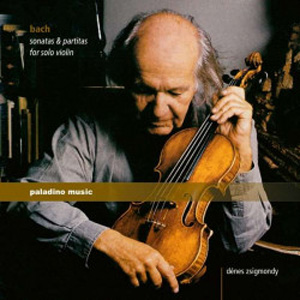Violinist Dénes Zsigmondy (1922-2014) may not be a familiar name outside of professional circles, yet he enjoyed a long career as both performer and pedagogue (perhaps Isabelle Faust is his best known pupil). He had close associations with composers including Kodály, Sessions, Dallapiccola, and Kurtag, the latter who dedicated his Signs, Games and Messages to Zsigmondy. He made a good amount of recordings, mostly in collaboration with his pianist wife Anneliese Nissen, who died in 1994. The following year Zsigmondy arranged for a DAT machine and microphones to be set up in the Church of St. Johann Baptist in Holzhausen, and, without anyone else, recorded Bach’s Sonatas and Partitas, resulting in more than 50 hours of raw material. In 1996 Martin Rummel and Robert Müller sorted through the material and cobbled together a CD edition that appears here for the first time in a general commercial release.
To be sure, Zsigmondy’s focused and penetrating tone lacks the rounded elegance of Milstein or Grumiaux, and he betrays small intonation lapses here and there. Yet Zsigmondy’s seasoned musicianship and insights constantly manifest themselves throughout these recordings. He takes an unusually animated tempo for the G major sonata’s opening Adagio, while keeping the main melody notes and their neighboring decorative passages in textural perspective as the phrases fall over the bar lines. The similarly animated Fugue unfolds with much diversity in voicing, and one can say the same for the A minor sonata Fugue.
Zsigmondy’s palpable sense of harmonic tension and release in the Presto compensates for tiny blemishes, and likewise for the B minor partita’s Double and Presto. The light and flickering character of Zsigmondy’s arpeggiated chords marvelously accentuates the Bourrée’s inner rhythm, while the E major partita’s tempos all around suggest that Zsigmondy may have supplemented his violin practicing by taking dance classes. And the C major sonata’s Largo also benefits from Zsigmondy’s animated tempo and varied doses of vibrato.
The catalog certainly boasts more technically refined and super-detailed performances of the great D minor Chaconne, but Zsigmondy’s innate feeling for the music’s dramatic peaks and valleys, organically unified tempo relationships, adroit transitions, and overall flexibility breathe vibrant life and meaning into a work that is too often handled with kid gloves and reverential self-awareness.
For tonal allure along with musical substance, I still recommend our reference versions, together with a desire to see Uto Ughi’s musicianly, virtuosic RCA recording from the early 1990s reissued. In a certain sense, Zsigmondy reminds me of Joseph Szigeti or Paul Zukofsky in that he seems content to check artifice and surface beauty at the door in pursuit of the truth. Well worth hearing.
































